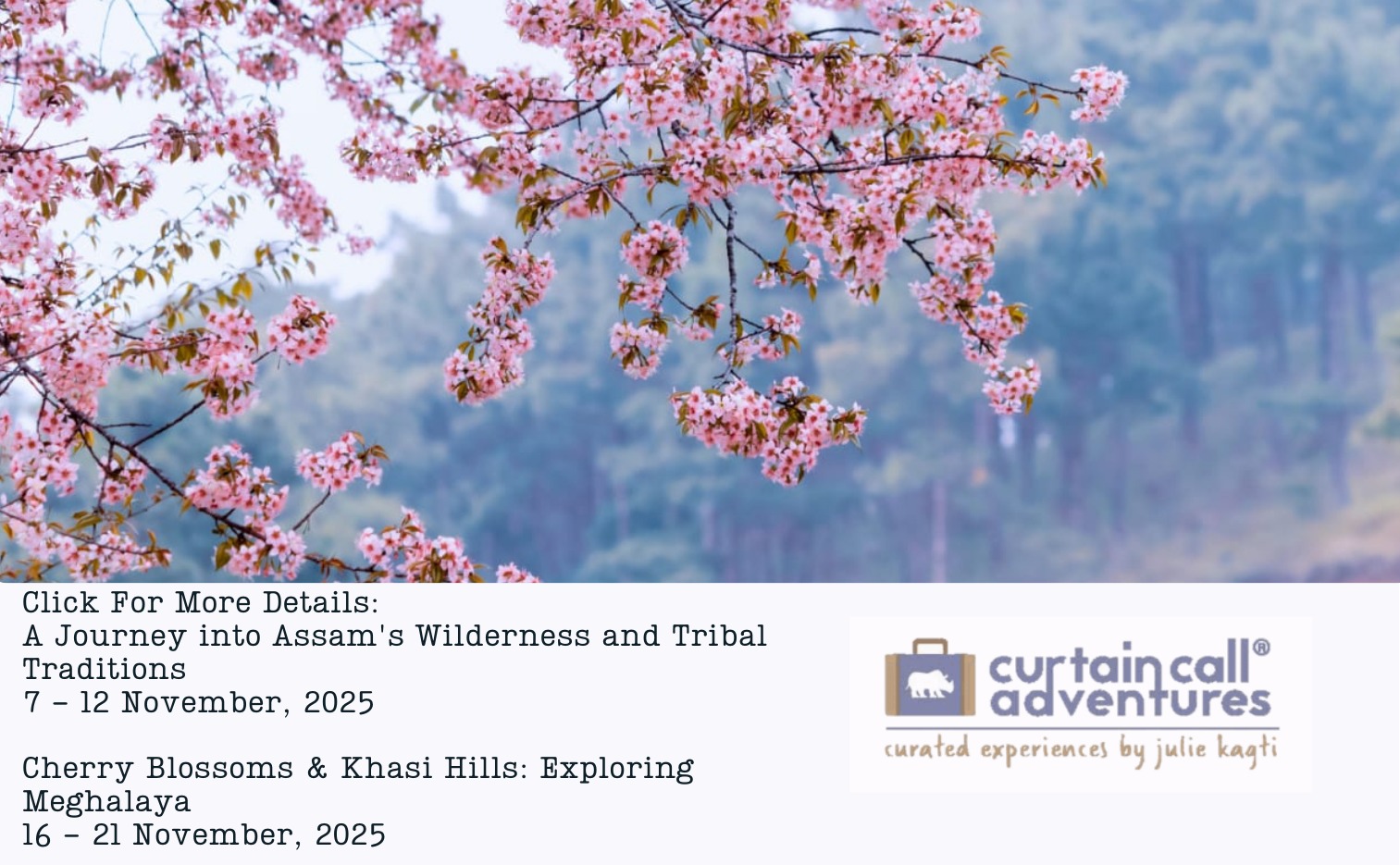There is an old Greek proverb that beautifully encapsulates the essence of legacy: “A society grows great when old men plant trees whose shade they know they shall never sit in.” For Hally War*(69), this saying was not merely a philosophical reflection but a guiding principle throughout his life, as he dedicated himself to passing down intergenerational knowledge to his fellow tribespeople in Meghalaya.
Hally War’s journey began at the tender age of ten when a transformative idea took root in his mind. Witnessing the daily struggles of his parents as they navigated the treacherous waters of a river to reach their farm, young Hally felt compelled to make a change. He envisioned not just any bridge but a living root bridge, one that would harness the natural strength of the surrounding trees. Inspired by tales from his grandfather, Hally began weaving these natural wonders at just ten years old. Fast forward sixty years, and Hally’s dream has flourished into a breathtaking reality. His remarkable creation now spans the Umkar River in Siej village, located near the picturesque town of Cherrapunjee, also known as Sohra, in the undulating East Khasi Hills of Meghalaya. This living marvel stands as a testament to his vision, creativity, and dedication to fostering a sustainable relationship between his community and the environment.
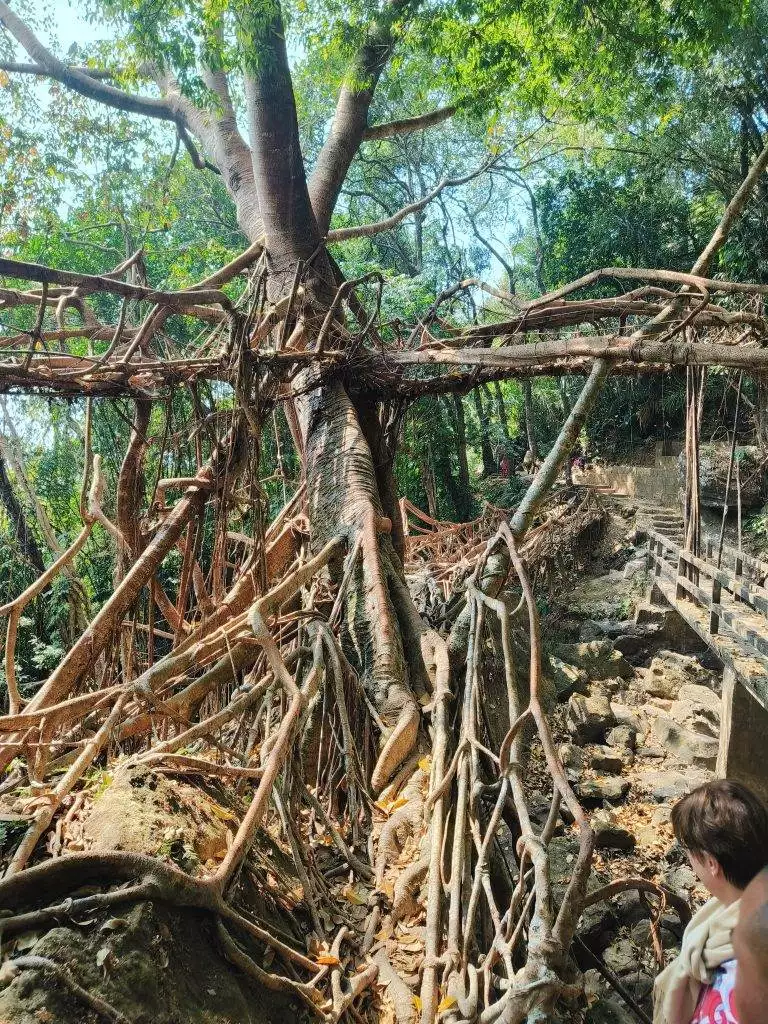
In my recent interview with Hally War, he shared his journey and profound connection to farming, revealing how his father’s commitment to horticulture has significantly inspired him. From a young age, Hally learned to cultivate a diverse array of crops, including betel nuts, betel leaves, bay leaves, black peppers, long peppers, broomsticks, and pineapples. He fondly recalled how, at the age of 8, he watched his grandfather plant the rubber fig trees that would ultimately lay the groundwork for the community’s renowned living root bridges
He explained that his father taught him the vital technique of guiding and training the roots, especially during the monsoon season. This careful nurturing process allowed the roots to grow naturally with the support of bamboo and betel nut trees, eventually forming the living root bridges. These structures not only facilitate safe passage across streams during the rainy season but also serve his community, providing a crucial link for those who traverse these waterways daily. Hally began following in his father’s footsteps at around the age of 10 and has remained committed to this work ever since. His passion for horticulture and sustainable practices continues as he actively teaches his sons the same skills and values, ensuring that this rich heritage and wisdom are passed down through generations.

The jingkieng jri, locally known as the living root bridges, seem to have sprung straight out of the pages of a Tolkien fantasy. As you approach these remarkable structures, the sight of interwoven aerial roots creates a magical, almost ethereal atmosphere. The roots twist and turn with an organic grace, forming intricate patterns that appear to dance in harmony with the whispers of the wind. It feels as though these living bridges possess a life of their own, binding together not just the two banks of the river, but also the realms of myth and reality. As sunlight filters through the dense canopy of leaves above, the play of light and shadow on the roots enhances the feeling that one has entered a fairy-tale realm. The jumbled roots, some thick and gnarled, others slender and delicate, stretch across the river like ancient fingers clasping the earth, weaving tales of resilience and adaptability. Each step on these bridges resonates with the footsteps of countless generations, echoing stories that blend the past with the promise of the future.
Rather than merely facilitating a river crossing, the jingkieng jri offer a profound connection to the surrounding landscape. They invite onlookers to ponder the interplay of nature and human creativity, reminding them that these structures are not just utilitarian but are alive with the spirit of the land and the community that nurtured them. Here, the boundaries between the mundane and the mythical dissolve, transforming a simple journey across the water into an experience steeped in wonder and reverence.
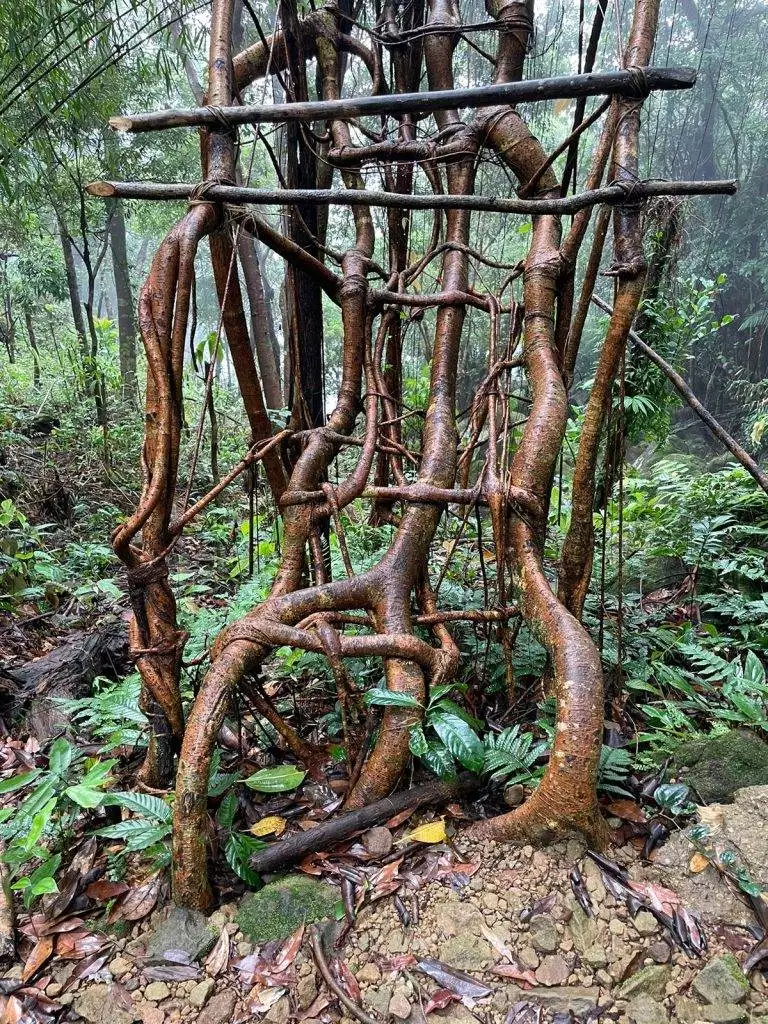
There are more than 100 living root bridges spread across the picturesque landscapes of the East Khasi and Jantia Hills. These remarkable structures vary in their condition; while some remain fully functional and actively used by the local population, many others have succumbed to the ravages of time, becoming broken, rotted, or completely engulfed by the encroaching forest.
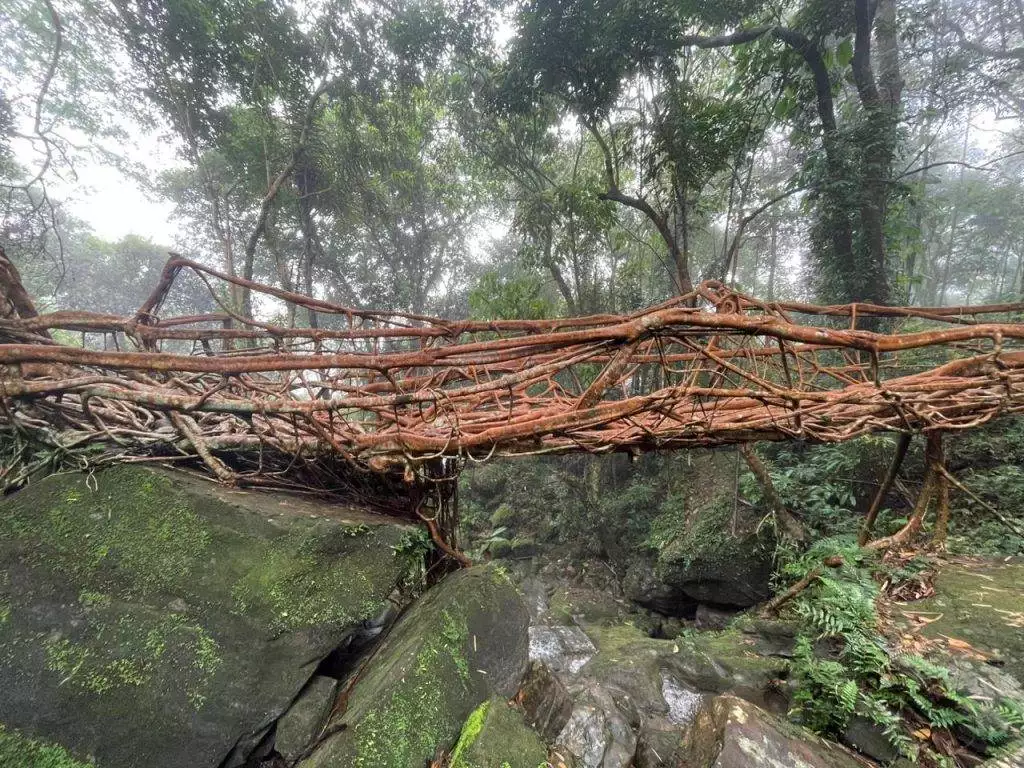
One of the most intriguing features of these living root bridges is their unique ability to self-renew and self-strengthen. As long as the tree from which a bridge is formed remains healthy, the bridge continues to thrive and evolve. The component roots grow thicker and more robust over time, enhancing the bridge’s structural integrity. This natural process allows the bridges to adapt and withstand various environmental stresses. In addition to their impressive architectural qualities, living root bridges boast their own intricate ecosystems. They provide a habitat for a diverse array of flora and fauna, supporting various species that thrive on and around them. This biodiversity not only enriches the local environment but also highlights the deep symbiotic relationship between these traditional structures and the surrounding landscape. The living root bridges are not just pathways; they are vibrant ecosystems that reflect the harmony of nature and the ingenuity of human craftsmanship, embodying a sustainable way of living that has persisted through generations.
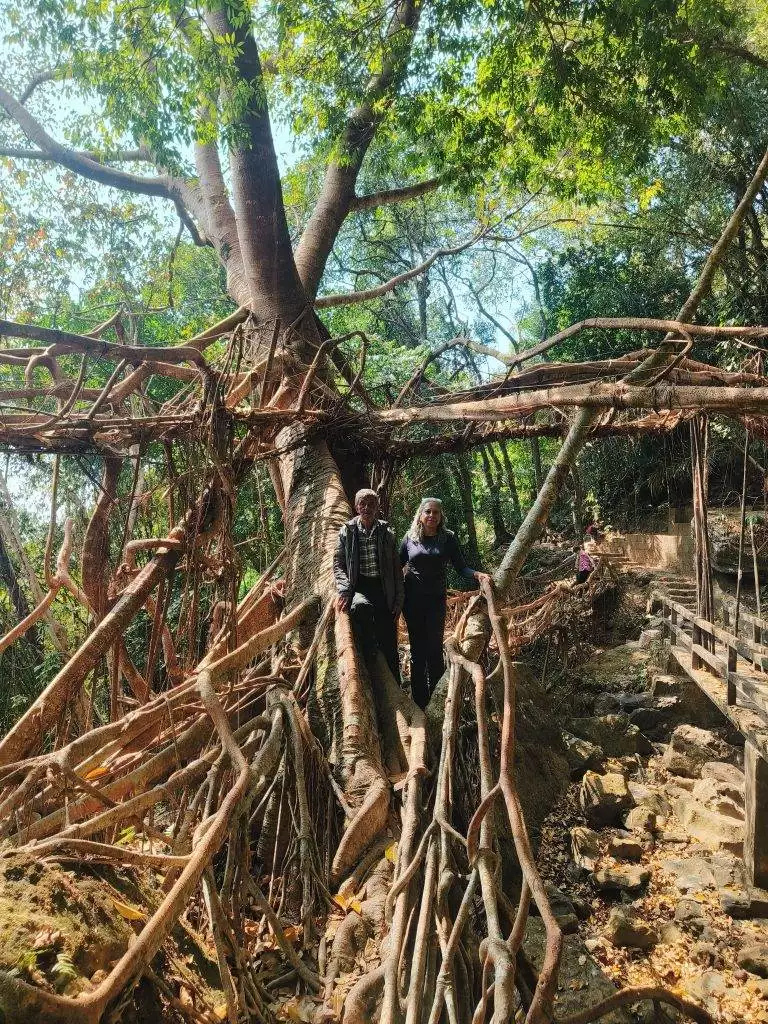
The Umkar root bridge is more than just a means to traverse the river; it stands as a powerful symbol of the deep cultural and spiritual ties that bind the local community to their environment. Each intertwining root narrates a story of resilience and adaptation, reflecting the artful mastery of traditional techniques passed down through generations. As it arches gracefully over the flowing waters, the bridge captures the essence of harmony between mankind and nature. In its majestic form, Hally’s root bridge does not merely fulfill a functional purpose; it embodies the spirit of sustainability and the ingenuity inherent in Meghalaya’s rich heritage. It serves as a tangible reminder of the importance of nurturing our surroundings and leaving behind a legacy that future generations can be proud of. Through the lens of the Umkar root bridges, we witness not only a physical connection between two banks of a river but also a bridge connecting the past to the future and a celebration of the enduring relationship between the community and the lush landscapes they inhabit.

Every living root bridge is more than a functional structure; it embodies the art of transformation—an agile response to the challenges posed by nature. These remarkable creations reveal a masterpiece of human creative genius, culminating in works that reflect an intimate relationship with the landscape. Within these bridges lies the spirit of collaboration between human hands and nature, demonstrating how cultural heritage can thrive through sustainable practices. Ultimately, the living root structures stand as enduring symbols of ecological balance, creativity, and a legacy that future generations will continue to honor and cherish. The root bridge is not merely a structure; it embodies the spirit of resilience and innovation, showcasing the legacy that Hally War has crafted for future generations.
*War – The “War” tribe in Meghalaya is a subgroup of the larger Khasi people, also known as Hynniewtrep. They are predominantly found in the southern part of the Khasi and Jaintia Hills, bordering Bangladesh, and are known for their traditional knowledge and utilization of bioresources.
*Jingkieng Jri- The Jingkieng Jri in Meghalaya are 72 bridges and other structures built by remote communities from the roots of ficus trees. The indigenous Khasi community developed a technique to plant saplings and nurture them into a strong structure.
Planning on visiting Umkar root bridges, here’s all you need to know –
It is possible to visit the Umkar Root Bridge throughout the year, owing to its easy accessibility. Each season brings its own unique charm to this Cherrapunji wonder, offering visitors a different experience. In summer, the greenery is particularly vibrant, and the pleasant weather makes for a delightful walk. During the monsoon, the landscape transforms as lush forests flourish and river streams swell, creating breathtaking scenery, though the paths can become slippery. Winter provides clear skies and tranquil surroundings, making it an ideal time for photography. Regardless of the season, this single-decker root bridge remains a stunning destination worth exploring.
Please note – Though the bridges remain accessible throughout the year, we do not recommend visiting during monsoon season as the road to Umkar gets affected, making it slippery to walk the steps and bridge itself.
Starting Point: Your journey to the Umkar Root Bridge begins in Siej village. Upon arriving at the base village, it’s just a 10-minute walk through the forests to reach the bridge. Make sure to pay the parking fee of ₹30 per vehicle at the Umkar Root Bridge Parking area in Siej village.
By Air: The nearest airport is Shillong Airport, located around 95 km from Siej village. Alternatively, you can fly into Guwahati Airport, which is 180 km away and offers more frequent connections to major Indian cities. After arriving at either airport, you can hire a cab or a local taxi to reach Siej village.
By Rail: The nearest railway station is Guwahati Railway Station, approximately 160 km away. From there, you can take a taxi or a cab to the base village.
By Road: If you prefer to travel by road, Shillong has good connectivity via National Highways to various parts of the country. From Shillong, it takes about 70 km to drive to Siej village.
For a more enjoyable experience, it is advisable to arrive in Shillong or Cherrapunji a day before your visit to the Single-Decker Root Bridge. This allows you time to rest before your trek the following day.
Location
The Umkar Root Bridge is situated in the serene environment of Siej Village, surrounded by thick forests and flowing streams. A well-maintained road leads you to this tranquil spot, making it perfect for escaping into the beauty of nature—truly a hidden gem in Meghalaya.
Accessibility
The Umkar Single-Decker Root Bridge is easily accessible, making it suitable for visitors of all ages. Whether you’re with older family members or young children, the path to the bridge is manageable. In contrast to the famous double-decker Cherrapunji Root Bridge, which requires a strenuous hike of 3,600 steps, this journey involves only a brief 10-minute trek through a peaceful, bamboo-filled forest.
Lesser Crowd
This Root Bridge, one of Meghalaya’s lesser-known wonders, offers a more intimate experience compared to the crowded living root bridges. With fewer visitors, you can truly appreciate the serene environment and connect with nature undisturbed.
Natural Beauty
Set against a picturesque waterfall and a gentle river stream, the Umkar Root Bridge is enveloped by lush greenery, making it an ideal spot for relaxation. You can even enjoy a refreshing dip in the water below!
Educational Experience
What makes the Umkar Root Bridge particularly fascinating is that it’s still under construction. The locals are actively rebuilding it after flood damage, showcasing the ongoing process of creating these unique bridges by weaving rubber tree roots with the sturdy trunks of betel nut trees. Observing this dynamic growth provides valuable insight into traditional ecological knowledge and sustainable engineering practices.
Moreover, locals are guiding new roots to form a double-decker bridge above the existing structure, allowing visitors to witness a remarkable example of nature’s evolution.
Communal Efforts
Visiting the Umkar Root Bridge also highlights the dedication of local tribes who have nurtured these living structures over the years. This bridge symbolizes community spirit, demonstrating how humans can coexist harmoniously with nature to create something functional yet beautiful. It serves as a reminder of the legacy of sustainable practices and traditions in today’s world.

